AI Business Process Automation: The New Standard for Business
- November 13
- 13 min

Artificial Intelligence (AI) is revolutionizing industries, and business analysis is no exception. By assisting with tasks like requirement gathering, workflow analysis, and actionable feedback generation, AI offers powerful tools to enhance efficiency and precision. However, as organizations explore AI’s potential, maintaining data privacy and system security must remain a priority.
This article explores how AI can support business analysis initiatives effectively while ensuring the confidentiality and security of sensitive business data. We’ll also share practical tips for implementing AI into your workflows responsibly.
Key takeaways:
AI can convert mundane, manual business analysis tasks into streamlined, automated processes. Its ability to process and analyze large datasets at incredible speed enables analysts to focus on high-level strategy rather than operational details.

Here are the ways AI elevates business analysis initiatives:
AI-driven transcription tools can make gathering requirements faster and more precise. Business analysts often rely on notes from client meetings, which can be time-consuming and prone to inaccuracies. AI transcription software captures spoken discussions in real-time, ensuring no details are overlooked. It can also highlight recurring topics or key concerns raised by stakeholders to guide decision-making.
Practical Example:
Privacy Best Practices:
To safeguard sensitive information during requirement gathering:
Mapping and analyzing complex workflows requires attention to granular details that are often time-intensive. AI offers a way to study workflows comprehensively, identify inefficiencies, and recommend improvements. AI can visualize workflows dynamically, eliminating redundancies and optimizing processes for better outcomes.
Practical Example:
Privacy Best Practices:
To perform workflow analysis securely:
Feedback from various stakeholders and team members is essential in delivering effective solutions. AI can assist in gathering, organizing, and analyzing feedback to detect trends, uncover hidden issues, and evaluate decision-making processes. This enables business analysts to refine their strategies and adopt a continuous improvement mindset.
Practical Example:
Privacy Best Practices:
AI-based diagramming tools remove the struggle of manually creating flowcharts or dependency maps. Feeding task data into AI systems can automate the creation of process diagrams and system architecture maps, saving hours in visual documentation.
Practical Example:
Privacy Best Practices:
AI automates processes and generates insights, but organizations must take deliberate measures to protect sensitive business data. Many AI applications learn and improve based on the information they process. This poses potential risks if protections aren’t in place.
Risks to Avoid:
Steps to Secure AI Use in Business Analysis:
Introducing AI doesn’t require a complete overhaul of existing workflows. Strategic, incremental adoption can ensure proper usage with minimal disruption.
Recommendations for Businesses:
Artificial Intelligence (AI) is automating routine tasks and enabling faster analysis. By taking over time-consuming activities such as data entry, report generation, and trend analysis, AI allows BA to focus on more strategic outcomes of the analysis work.
During requirement gathering, AI tools can assist in identifying and predicting customer needs by analyzing historical data and market behaviors. Natural language processing (NLP) enables AI to extract meaningful information from unstructured text, such as customer feedback or meeting notes, streamlining the documentation process.
To find information about a tool’s security approach and commitment, you can explore the following resources:
|
Resource |
Details |
|
Official Website |
Look for a dedicated “Security” or “Privacy” section outlining data handling practices, compliance certifications, and security measures. |
|
Terms of Service and Privacy Policy |
Review these documents for detailed information about data usage, storage, and sharing practices. |
|
Compliance Certifications |
Check for compliance with industry standards like GDPR, HIPAA, SOC 2, or ISO 27001 to ensure high security and privacy standards. |
|
Security Whitepapers |
Search for whitepapers or technical documentation in the “Resources” or “Documentation” sections detailing security architecture and protocols. |
|
Customer Support or Sales Teams |
Contact the tool’s support or sales team to ask specific questions about security practices and data protection measures. |
|
Third-Party Reviews and Audits |
Look for independent reviews or third-party security audits to gain unbiased insights into the tool’s security capabilities. |
|
Community Forums or User Groups |
Engage with user communities or forums to learn about real-world experiences with the tool’s security features. |
By thoroughly researching these resources, you can ensure the tool aligns with your organization’s privacy and security requirements.
AI has the potential to transform business analysis, delivering quicker insights, improving decision-making, and automating repetitive tasks. By integrating tools that assist with requirement gathering, workflow evaluations, and stakeholder feedback, organizations can enhance productivity and efficiency.
Alongside adopting AI, safeguarding privacy and maintaining the confidentiality of sensitive information must remain priorities. Businesses that invest in secure systems, protect data, and provide proper training to their teams can reap the benefits of AI while upholding client trust and compliance requirements.
With these strategies in place, AI can act as a powerful ally in driving better outcomes for business analysis initiatives, all while respecting the boundaries of information protection.
AI automates routine tasks like transcription, workflow analysis, and feedback organization, allowing analysts to focus on strategic decision-making and improving productivity.
Use secure platforms, disable data retention features, anonymize inputs, and conduct regular security audits to protect sensitive business data.
AI can assist with requirement gathering, workflow visualization, feedback analysis, and creating process diagrams, making business analysis more precise and impactful.
Start with pilot programs, train teams on responsible AI use, collaborate with IT for secure integration, and implement clear data governance frameworks.
Look for compliance with industry standards like GDPR, HIPAA, SOC 2, or ISO 27001 to ensure the tool meets high security and privacy standards.
